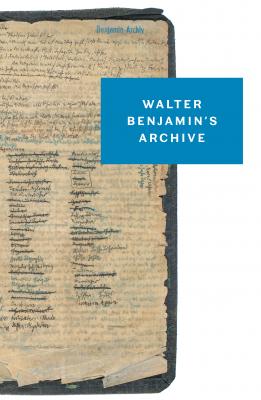Walter Benjamin’s Archive. Walter Benjamin
Чтение книги онлайн.
Читать онлайн книгу Walter Benjamin’s Archive - Walter Benjamin страница 8
 Notes for Franz Kafka (1934)—Manuscript, one side, with reverse side (extract). Compare GS II.3, p. 1207.
Notes for Franz Kafka (1934)—Manuscript, one side, with reverse side (extract). Compare GS II.3, p. 1207.
2.5 and 2.6 Proust and Kafka. Notes for Franz Kafka (1934)—Manuscript, one side, with reverse side. Compare GS II.3, p. 1221.
2.7 What is Aura?—Manuscript, one side.
2.8 and 2.9 Bibliographic notes—Manuscript, one side, with reverse side. These bibliographical notes on a purchase voucher are probably connected to Benjamin’s montage of letters for the 150th anniversary of the French Revolution, which appeared in the journal Europe on July 15, 1939 under the title “Allemands de quatre-vingt-neuf.”
Itemized here are, amongst other things, the biography of Seume by Oskar Planer and Camillo Reißmann (1898), the books Biedermeier in Chains (1924) and Prohibited Literature from Classical Times to the Present (1925) by Heinrich Hubert Houben, Gustav Landauer’s Letters from the French Revolution, Herder’s Letters for the Advancement of Humanity, Benjamin’s “Introduction to Jochmann,” Correspondence by Georg Forster and a letter from Jochmann to Kant.
2.10 and 2.11 Note for On the Concept of History: “Marx says that revolutions are the locomotives of world history. But perhaps it is quite different. Perhaps revolutions are what happens when the humanity travelling in this train snatches at the emergency brake.” (c. 1940)—Manuscript, one side, with reverse side. The reverse side appears to show calculations relating to the cost of a lunch. Compare GS 1.3, p. 1232.
Fig. 2.1
Fig. 2.1
Types of Knowledge
| I | The knowledge of truth |
| This does not exist. For truth is the death of intention | |
| II | Redemptive knowledge |
| This is the knowledge that dawns with redemption, which is thereby completed But it is not the knowledge that precipitates redemption | |
| III | Teachable knowledge |
| Its most significant form of appearance is banality | |
| IV | Determining knowledge |
| There is knowledge that determines action. It is, however, not determining as a “motive,” but rather due to the force of its linguistic structure. The linguistic moment in morality is connected to knowledge. It is absolutely certain that this knowledge that determines action leads to silence. Therefore, as such, it is not teachable. This determining knowledge is closely related to the concept of Tao. This is in direct contradiction to knowledge in Socrates’ Doctrine of Virtue. While this is motivating for action, it does not determine those who act. | |
| V | Knowledge from insight or perception |
| This type is highly enigmatic. In the region of knowledge, it is something that resembles the present in the region of time. It exists only as an ungraspable transition. From what to what? Between foreboding and the knowledge of truth. |
Fig. 2.2
Fig. 2.2
I
Sheet of paper has gone missing; must look for it at home. It contained:
1.The discussion of the concept of “system” and the doctrine of the extinguishing of intention in the truth, explained in terms of the veiled image of Sais.
2.Discussion of the concept of “essence” as the mark of truth.
Fig. 2.3
Fig. 2.4
Fig. 2.3
The Potemkin Story
The anecdote from Hamsun
The childhood photograph of Kafka
The little hunchback
The truth about Sancho Panza
Picture from the illustrated History of the Jews
Hasidic beggar story
The Next Village
Fig. 2.4
Dr Fritz Fränkel
Medical Specialist for
Nervous and Mental
Illnesses
207 Kaiserallee,
West Berlin 15
Telephone: B5
Barbarossa 5312
Fig. 2.5
Fig. 2.5
Proust and Kafka
There is something that Proust has in common with Kafka and who knows whether this can be found anywhere else. It is a matter of how they use “I.” When Proust, in his Recherche du temps perdu, and Kafka, in his diaries, use I, for both of them it is equally transparent, glassy. Its chambers have no local coloring; every reader can occupy it today and move out tomorrow. You can survey them and get to know them without having to be in the least attached to them. In these authors the subject adopts the protective coloring of the planet, which will turn grey in the coming catastrophes.
Fig. 2.6
Fig. 2.6
| La vie antérieureLes années profondesRecueillement | J’ai plus de souvenirs que |
Redonnée [?] The année profonde as seat of mystical experience and of spleen
Fig. 2.7
Fig. 2.7